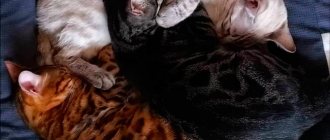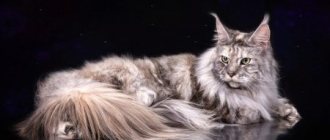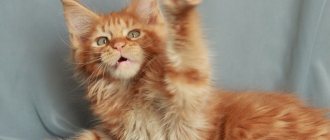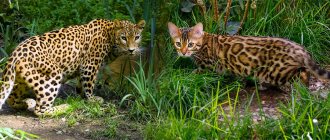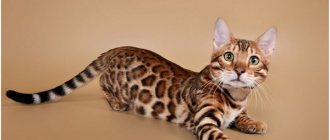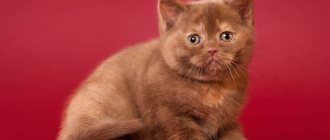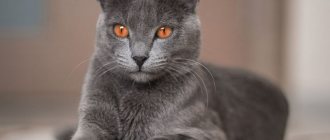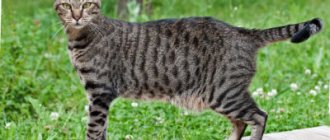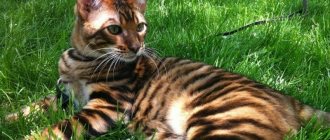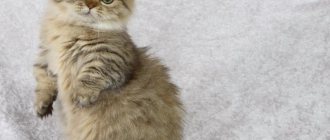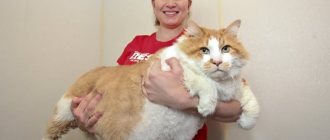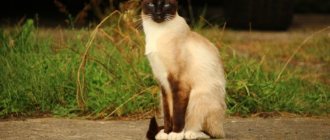Coat and color are a distinctive feature of the Bengal cat. Each pattern is individual: spots or stripes on a cat are like fingerprints on a person; no two are alike. Today, there are many colors of Bengal cats. The Snow Bengal stands out among all of them; it is even sometimes confused with another breed. Every cat lover dreams of having a little “leopard” at home.
Color standards
Outwardly, the Bengal cat always resembles its wild ancestors. On the muzzle there are contrasting dark stripes that resemble the letter “M” on the forehead. Light-colored whisker pads. The contours of the nose, lips and eyes are black or darker. Dark stripes on the neck, like a necklace, decorate it. There are often small stripes on the paws, but there may also be spots. The tail is also spotted or rosette, but its tip always remains black. All breeders strive to get as close as possible to the appearance of a wild cat. Therefore, the spotted belly and chest should preferably be lighter. It is not always possible to achieve such selective lightening - scientists still cannot definitively determine the gene that is responsible for this.
The colors of Bengals are distinguished by the color of the background and the type of pattern that is located on it. The most common are gold and silver backgrounds. There are snow bengals, among which there are lynx, mink, and sepia. The charcoal color is considered more rare. The blue color is also officially recognized.
How Snow Bengals Genetics Work
Since very different genes “work” in a variety, breeders rely on crossing tables. In this case, the main factors are taken into account when acceptable combinations of Bengal cats and cats of a given subspecies are taken into account.
- Links genotype is cs cs. A purebred Seal lynx can be obtained either from a pair of straight carriers, or from two minks, or if a mink and a lynx are mated. As a result of the manifestation of the white recessive gene, as well as numerous mutations, these Bengal cats occasionally give birth to white kittens with dark brown spots. Such exceptional snow-white individuals with aquamarine eyes are extremely popular, especially in America.
2. The sepia genotype is provided by the cb cb genes. In order to have purebred Seal Sepia in the litter, they themselves are crossed, or two minks, or a mink is offered as a pair to a Sepia cat. The eyes of this species of Bengal vary in yellow and golden-green palette.
3. It is logical that minks have cb cs genes as their genotype. Consequently, this variety of Snow Bengal can be found in litters from any combination involving Links, Sepia and the Minks themselves. Their eye color is interesting, like sea wave, but more often they are golden-green, like those of red-colored Bengal cats.
A feature of all leopard pets is the process of phasing in kittens, although it is less pronounced compared to brown tabbies, which in the wild need to hide their bright colors from their enemies. Few long, thin camouflage hairs grow, and by the age of four months the babies are free of them.
Pattern: spotted or marbled
Cat coloring is divided into two types:
- Spotted (from English spotted) or rosette (from English rosetted) pattern. In the first case, these are solid spots. In the second, the so-called sockets. The color inside the rosette should be darker than the background, which is completely or partially surrounded by a darker circle (closed and open rosette). The size of the spots or rosettes can range from small to large.
- Marble (from English marbled) pattern: represents various horizontal stripes. Circular or vertical marks are faults. It is more highly valued when the marble pattern of the Bengal contains three colors: the background shade, the pattern and its edging.
To distinguish the colors of Bengal cats, it is easier to use the table:
Features of phasing of brown tabby kittens
Phasing is a special phenomenon that domestic Bengals inherit from wild Asian Leopard Cats (ALC). It manifests itself in Bengal kittens, regardless of the distance of its ancestry from forest ancestors. The term “Fuzzy” from English “vague, shaded” accurately defines the essence of the natural process of masking spots. By the age of one month, kittens grow long, thin hair that hides bright markings. By about 4-5 months, babies' phasing hair falls out. On spotted young animals, the coloring appears faster, but in the marble variety, the streaks develop more slowly - the marbled cat finally blooms only at two years of age.
The unusual and fascinatingly intricate patterns of brown tabby fur coats determine the popularity of the young breed, which is in the stage of active development. It is brown Bengals, especially such an attractive rosette on gold, that occupy the highest level in the demand ratings.
Snow Bengal
Snow color is one of the rare ones. Snow Bengal kittens are divided into three groups depending on their genotype.
Links (Ben n 33) The background is represented by shades of cream or ivory. The pattern varies in tones of brown from light to dark. The head and paws are darker than the body. The tail is brown. These are the only snow bengals that are born completely white, and the pattern does not appear until they are one year old.
Mink (Ben n 32) They are often confused with the link color. The drawing from birth practically merges with the background and is hardly noticeable. The main difference is the eyes: their color varies from bright green to blue.
Sepia (Ben n 31) The color is lighter than golden, but darker than other snow Bengal cats. The difference between the background and the picture is small. The pads on the paws are brown, as is the tip of the tail. Eye colors include variations of green and yellow.
Coat and colors of long-haired Bengals (Cashmere)
Initially, the gene for long hair was considered an undesirable trait in the breed, but at the moment long-haired Bengals (Kashmirs) are already recognized by some international felinological systems.
The legitimacy of distinguishing Kashmir cats from the total number of Bengal cats has become a goal of many catteries. Breeders in the United States were keen to have these cats recognized as a variety of the Bengal breed due to their long hair - perhaps this is why TICA calls the breed Bengal Longhair. European breeders are trying to give Cashmere cats the status of a new, separate breed. So far, the term “Kashmir” is not widely used and is used mainly among specialists. At the same time, such cats are becoming increasingly popular; there are already nurseries of this breed in the USA, Europe (Germany, Poland, England), and Russia. In 2021, the first system to recognize long-haired Bengals as a separate breed was TICA. Today, Cashmere cats can take part in championships in the TICA, WOC, CFA, WCF systems.
Wool texture
Cashmere Bengals are a natural variation, so one cannot yet expect a uniform coat structure and length from its representatives. The length can be like that of a Turkish Angora cat or like that of a Maine Coon. But, unlike them, Kashmiris have no or almost no undercoat; their wool is closer in quality to the hair of a Bengal cat than to the wool of other long-haired breeds. The hairs are very thin, smooth, soft, pleasant to the touch - like cashmere fiber. This is where the name of the breed comes from - cashmere, which is preferred by breeders. In general, the quality of Kashmiri wool is the same as that of short-haired Bengals, the only difference being the length. This coat is easy to care for. Some believe that Kashmiri wool sheds less and is even hypoallergenic. This topic has not yet been fully studied, but definitely the molting period in these cats is almost invisible.
Colors
Long-haired Bengals have all the same colors as short-haired ones, including even the charcoal group. However, the Kashmiri does not have glitter, and the glitter is in no way related to the length of the coat: the kitten inherits this trait from its parents. The breeder’s task in this case is to select the appropriate pair.
In pattern, Cashmere cats are as beautiful and varied as short-haired Bengals. Their coats can be spotted or rosetted, or marbled, with dark curls contrasting with their light, silky fur.
How to tell if a kitten is Kashmiri
As adults, Kashmiris and Bengals are easy to distinguish from each other, but in infancy this is not always easy. When a litter is born, it is difficult to say which of the kittens will become long-haired if among the parents there is at least one short-haired one who carries the long-haired trait. And even if both parents are Bengals and carry the recessive gene for long hair, it is difficult to predict what their kittens' coat will look like. Most often, in one litter there are kittens with different hair lengths. Typically, the first signs of long hair appear between 4 and 12 weeks of age: you may see “pants” on the hind legs or long hairs in the ears.
Mixed bengal cat
Bengals are prohibited from crossing with other cat breeds. This is fraught with sick or completely non-viable offspring. However, some engage in this activity for commercial purposes. Such kittens can be found through frequent advertisements on the Internet. We warn you! Mixed breeds of the Bengal cat are not officially recognized. Such kittens do not belong to the Bengal breed. As a result, you can get a kitten that will not meet external standards, but also its character. Breeders carefully select affectionate and non-aggressive representatives. Otherwise, the genes may take over and you will end up with an uncontrollable animal. Long-haired mixed breed (cashmere bengal, silk bengal) is gaining popularity. The animal has a similar color. It is distinguished by a fluffy tail, a “collar”, and longer hair on the sides and back.
Description of the breed
Bengals are quite large representatives of domestic cats, with powerful long legs. The Bengal representative of the species is a short-haired cat with an amazingly shiny coat of a wide variety of colors.
Bengals have many varieties due to the large number of mixed breeds during the breeding of the Bengal breed.
The characteristics of the Bengal breed have both pros and cons in the description. Despite the fact that these beauties have a lot of wild blood in their blood, their behavior is not much different from ordinary domestic felines.
Bengals have the character traits characteristic of representatives of this breed; they are very freedom-loving, independent, at the same time playful and devoted to one owner.
Bengal kittens look like an ordinary three-haired domestic cat, and are in no way similar to representatives of Bengals.
Breed standard
Bengal cats have a breed standard that all representatives must meet. The parameters for this type are still being finalized, but general indicators have been determined.
- The size and weight of representatives of this breed are quite large. The weight of an adult cat can reach 7-8 kg. The height of a large cat can exceed 80 cm. Males are larger than cats
- The body is large and muscular. Well developed.
- The head is medium-sized, wedge-shaped, with a massive chin.
- Eye color can be blue, yellow and green.
- The neck is powerful and muscular.
- The ears are small and set high. Between the ears on the top of the head there is a pattern resembling the letter “M”.
- The hind legs are longer than the front legs.
- The coat is of medium or short length, reminiscent of rabbit fur, thick, silky.
- The tail is of medium length with rings or spots along its entire length.
- The color is spotted or marbled with an even pattern distribution.
Unrecognized colors
In addition to the standard color of Bengals, there are new options that have not yet received recognition:
- Carbonic. The type resembles silver, but the base tone is much darker. The clearly defined black pattern has no blur and is clearly visible against a gray or ashy background. The general color palette is cold. The nose of the Charcoal Bengal is black, and there is a light edging around the eyes.
- Melanistic. The almost monochromatic black Bengal cat with a faintly visible pattern belongs to this color. A kitten is born with a normal contrasting pattern, which with age completely covers up the glitter. Occasionally, melanistic Bengals may be a different color.
- Blue. This color option is characterized by a less bright pattern of bluish-gray color with a metallic sheen. The pattern consists of large rosettes or spots. The background of the coat is bluish-gray on the back and soft peach on the belly. The Blue Bengal cat is extremely rare.
The rarest colors
Sometimes, but there are Bengal cats that have a completely unusual color.
Melanistic
This is what the black Bengal cat is usually called because it is considered to have black patterns placed on an equally black background. This pattern resembles the coloration of a black panther (a special color variant of the wild leopard).
The design and title background of these Bengals are black in color. The pattern is clearly visible in the sun's rays, and therefore one can understand that this is a Bengal breed and not some other breed.
The black Bengal cat is an extremely rare species of this breed. Breeders' associations most often do not approve of this type of color, so it is not considered popular.
Charcoal color
In this case, the color of the Bengal coat is based on cool and light tones of gray. The main pattern will be most clearly and clearly outlined on them. There are almost no blurry spots or stripes here; the pattern is bright and clearly visible against the faded background of the main color. This cat has a light rim around its eyes. The spots are scattered quite evenly on the cat's body, the color is similar to the traditional spotted color, but stands out with a brighter and darker color pattern.
Blue
This is a very rare color of Bengals. The coat of babies with this color looks like silver, but has a pleasant blue tint.
This is a smoky-colored kitten, with a visible blue coat; sometimes almost imperceptible gray spots can appear on it.
Most often they are in the shape of a circle; there may be stripes on certain parts of the body.
You can often see a peach tint on the kitten’s stomach and chest area. The blue color is considered today to be the last Bengal color that has appeared officially and that a cat can have.
Snow
Snow color, which is recognized as the lightest, and at the same time is also very impressive and original, is divided into the following types.
- Sepia. It is considered the darkest of all snow Bengal colors. The background is a catchy gold, very close to a highlighted orange. The colors of the body and spots are not very distinguishable. The paw pads and the tip of the tail will have a striking brown tint. The eyes play with a golden or bright yellow undertone.
- Minx. The main background has a cream or golden tone. The patterns on the cat's body can be either dark orange or light brown, quite contrasting with the main color. The tip of the tail is brown. Eye color – bright blue, piercing.
- Links. The main color comes in stunning shades of ivory and sometimes comes in cream. The patterns on the body are most often marbled, but rosettes and even spots can occur. The paws, muzzle, tail and ears will be significantly darker than the main background. The eyes are blue.
Kittens of all the listed colors have a white or light color at birth; as they grow (not earlier than the animal is one year old), the pattern begins to change - it becomes clearer. The color “matures” completely by about 1.5 years, when the cat becomes an adult.
More details about the Bengal cat are described in the video below.
